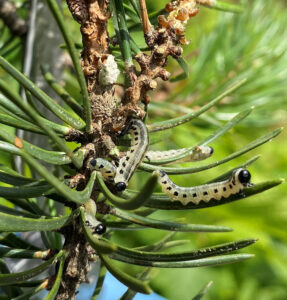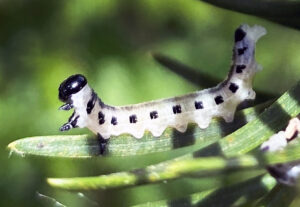
Neodiprion maurus larvae, feeding on jack pine, are gregarious. Can you spot all five larvae? / Photo Credit: Wisconsin DNR
By Linda Williams, DNR Forest Health specialist, Woodruff
Linda.Williams@wisconsin.gov or 920-360-0665
In mid-July, a few sawfly larvae were found feeding on jack pine in northern Vilas County. After delving into associated literature and reaching out to a sawfly researcher at the University of Kentucky, the sawflies were identified as Neodiprion maurus. There is no official common name for this insect; it is generally referred to as “a sawfly on jack pine.”
These sawflies are gregarious and feed in groups on older needles, doing relatively minimal damage. They are often referred to as “rare” and have been found in Michigan, Minnesota and Wisconsin, as well as Alberta, Manitoba and Saskatchewan in Canada.
Scouring past Wisconsin Department of Natural Resources Forest Health annual reports, this sawfly was noted just three times: in 1985 in Jackson County, 1992 in Eau Claire County and 1996 in Oneida County. There was also a Wisconsin report from a 2014 research study in Oneida County.

Neodiprion maurus, an uncommon sawfly on jack pine, with raised head and tail in a pose meant to scare predators by making them look larger and pointier. / Photo Credit: Wisconsin DNR
This unique sawfly overwinters as an adult within its cocoon. Adults emerge in the spring. Eggs are inserted into needles in the spring and hatch in late spring. In northern Wisconsin, larvae feed in June and early July. There is one generation per year.
Larvae have extremely shiny black heads and pale bodies, with dark stripes along their backs and dark squares along their sides. These larvae can resemble Neodiprion pratti banksiana, but that sawfly overwinters as an egg, and larvae hatch and feed earlier in the spring.
No control is necessary because this sawfly is not common. It feeds on older foliage and appears to have one or two natural enemies.
